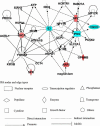Identification of genes influencing skeletal phenotypes in congenic P/NP rats
- PMID: 20200994
- PMCID: PMC3153136
- DOI: 10.1002/jbmr.8
Identification of genes influencing skeletal phenotypes in congenic P/NP rats
Abstract
We previously showed that alcohol-preferring (P) rats have higher bone density than alcohol-nonpreferring (NP) rats. Genetic mapping in P and NP rats identified a major quantitative trait locus (QTL) between 4q22 and 4q34 for alcohol preference. At the same location, several QTLs linked to bone density and structure were detected in Fischer 344 (F344) and Lewis (LEW) rats, suggesting that bone mass and strength genes might cosegregate with genes that regulate alcohol preference. The aim of this study was to identify the genes segregating for skeletal phenotypes in congenic P and NP rats. Transfer of the NP chromosome 4 QTL into the P background (P.NP) significantly decreased areal bone mineral density (aBMD) and volumetric bone mineral density (vBMD) at several skeletal sites, whereas transfer of the P chromosome 4 QTL into the NP background (NP.P) significantly increased bone mineral content (BMC) and aBMD in the same skeletal sites. Microarray analysis from the femurs using Affymetrix Rat Genome arrays revealed 53 genes that were differentially expressed among the rat strains with a false discovery rate (FDR) of less than 10%. Nine candidate genes were found to be strongly correlated (r(2) > 0.50) with bone mass at multiple skeletal sites. The top three candidate genes, neuropeptide Y (Npy), alpha synuclein (Snca), and sepiapterin reductase (Spr), were confirmed using real-time quantitative PCR (qPCR). Ingenuity pathway analysis revealed relationships among the candidate genes related to bone metabolism involving beta-estradiol, interferon-gamma, and a voltage-gated calcium channel. We identified several candidate genes, including some novel genes on chromosome 4 segregating for skeletal phenotypes in reciprocal congenic P and NP rats.
(c) 2010 American Society for Bone and Mineral Research.
Figures
Similar articles
-
Quantitative trait locus for body weight identified on rat chromosome 4 in inbred alcohol-preferring and -nonpreferring rats: potential implications for neuropeptide Y and corticotrophin releasing hormone 2.Alcohol. 2013 Feb;47(1):63-7. doi: 10.1016/j.alcohol.2012.10.005. Alcohol. 2013. PMID: 23312492 Free PMC article.
-
Candidate genes for alcohol preference identified by expression profiling in alcohol-preferring and -nonpreferring reciprocal congenic rats.Genome Biol. 2010;11(2):R11. doi: 10.1186/gb-2010-11-2-r11. Epub 2010 Feb 3. Genome Biol. 2010. PMID: 20128895 Free PMC article.
-
Bone mass and strength: phenotypic and genetic relationship to alcohol preference in P/NP and HAD/LAD rats.Alcohol Clin Exp Res. 2005 Oct;29(10):1769-76. doi: 10.1097/01.alc.0000183005.28502.4f. Alcohol Clin Exp Res. 2005. PMID: 16269906
-
From QTL to candidate gene: a genetic approach to alcoholism research.Curr Drug Abuse Rev. 2009 May;2(2):127-34. doi: 10.2174/1874473710902020127. Curr Drug Abuse Rev. 2009. PMID: 19630743 Free PMC article. Review.
-
The complexity of alcohol drinking: studies in rodent genetic models.Behav Genet. 2010 Nov;40(6):737-50. doi: 10.1007/s10519-010-9371-z. Epub 2010 Jun 15. Behav Genet. 2010. PMID: 20552264 Free PMC article. Review.
Cited by
-
Network Analysis Implicates Alpha-Synuclein (Snca) in the Regulation of Ovariectomy-Induced Bone Loss.Sci Rep. 2016 Jul 5;6:29475. doi: 10.1038/srep29475. Sci Rep. 2016. PMID: 27378017 Free PMC article.
-
Screening of differentially expressed genes in male idiopathic osteoporosis via RNA sequencing.Mol Med Rep. 2018 Jul;18(1):67-76. doi: 10.3892/mmr.2018.8985. Epub 2018 May 7. Mol Med Rep. 2018. PMID: 29750314 Free PMC article.
-
Genetic regulation of bone strength: a review of animal model studies.Bonekey Rep. 2015 Jul 8;4:714. doi: 10.1038/bonekey.2015.83. eCollection 2015. Bonekey Rep. 2015. PMID: 26157577 Free PMC article. Review.
References
-
- NIH. Consensus Development Conference: diagnosis, prophylaxis and treatment of osteoporosis. Am J Med. 1993;94:646–650. - PubMed
-
- Arden NK, Baker J, Hogg C, Bann K, Spector TD. The heritability of bone mineral density, ultrasound of the calcaneus and hip axis length: a study of postmenopausal twins. J Bone Miner Res. 1996;11:530–534. - PubMed
-
- Peacock M, Turner CH, Econs MJ, Foroud T. Genetics of osteoporosis. Endocr Rev. 2002;23:378–383. - PubMed
-
- Ralston SH, Galwey N, MacKay I, et al. Loci for regulation of bone mineral density in men and women identified by genome wide linkage scan: the FAMOS study. Hum Mol Genet. 2005;14:943–951. - PubMed
-
- Klein RF, Carlos AS, Vartanian KA, et al. Confirmation and fine mapping of chromosomal regions influencing peak bone mass in mice. J Bone Miner Res. 2001;16:1953–1961. - PubMed
Publication types
MeSH terms
Grants and funding
LinkOut - more resources
Full Text Sources
Medical
Molecular Biology Databases
Miscellaneous


